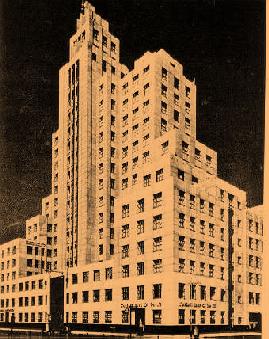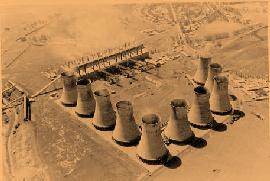Roots were Established - "All that glitters is gold"
- In 1932 South African mining received a major boost when the discovery of gold fields near Randfontein coincided with a steep rise in the gold price. It became clear that ESCOM would have to build new power stations to satisfy the increasing demand for the gold mines. But first, there were two major obstacles to be overcome: the VFP had a virtual monopoly on electricity supply to the gold mines, and there was a serious shortage of water near the Rand.
- In 1933 ESCOM put its finances on the front foot by floating loans (by public subscription) worth £3m. The South African public showed confidence in the organisation; the loans were over-subscribed before closing, and ESCOM repaid £2 250 000 to the government.
- The following year ESCOM raised another loan for £6 750 000 (again by public subscription and which was again oversubscribed) and settled its outstanding debt to the government, which at that time stood at £5 750 000. In just 11 years ESCOM had repaid its £8m debt to government and from then on raised capital via public subscriptions within South Africa. This was no small achievement given that the two government loans were redeemable in 1954 and 1979. The 1933 Annual Report proudly notes that “as a result of the repayment of the above loans the saving to the Commission’s consumers, calculated over the period of these loans, will exceed £5 750 000.”
- Although it could raise the capital, ESCOM did not have the expertise to build and run a massive power station; that was something only the VFP could handle. But the VFP was a private company whose central purpose was to generate profits for shareholders. ESCOM, on the other hand, was set up to “stimulate the provision of a cheap and abundant supply of electricity”, and was run for the good of the South African public. Dr van der Bijl was adamant that any further expansion to the grid should be financed and owned by ESCOM so that the country as a whole, and not private shareholders, would benefit from economic development. In the 1933 Annual Report, mention is made that in March 1934 ESCOM applied, and received, permission from the Minister of Commerce and Industries to establish “an undertaking for the supply of electricity on the Witwatersrand and in the adjoining areas.” The license for the undertaking, which became known as the Rand Extension Undertaking and ultimately covered an area stretching from Delmas in the east to Klerksdorp in the west, was ceded to the VFP. This meant that ESCOM would provide the capital for the VFP to design, build and run substations and transmission lines in this 29 000 square kilometre area. It was also noted in the 1933 Annual Report that the Minister had approved the establishment of a “generating station in the Vereeniging District of the Transvaal”. This was the Klip power station, which was to be designed and built by the VFP, and financed by ESCOM. In the event the VFP teamed up with Charles Merz’s firm of consulting engineers (Merz & McLellan) in the design of the power station. However, the water shortage problem was to be solved by a leading South African engineer, Dr FE Kanthack, who was appointed the Civil Consulting Engineer on the project. Thanks to Dr Kanthack’s innovative cooling towers only 1% of the total flow of water would be lost to evaporation, and the meagre flow of the Klip River would not be overly taxed.
- Meanwhile in 1934, in the Cape, the Salt River power station more than doubled in size when two 20 MW sets were added. The following year a further 20 MW (with a generating voltage of 33 kV) set was added bringing its overall generating capacity to 90 MW. By 1938 the Cape Municipality had completed their own power station, Table Bay, which then became part of a pooling agreement with Salt River, which was relegated to a peak load system. The pooling system demonstrated the advantages of interconnected power stations and centralised control, and proved the farsightedness of the Electricity Act which had envisaged ESCOM as a co-ordinator of electricity suppliers.
- In 1938 work began on the Vaal power station, which was situated just south of Vereeniging, and was the first ESCOM station in the Orange Free State (now known as the Free State). Similar to Klip, the Vaal power station was to be financed by ESCOM, but built and run by the VFP.
- In 1939 ESCOM decided to beef up Durban’s power supply by building a second power station at Congella. Advances in technology meant that the new power station’s boilers would boast steam pressures of 4.3 MPa (which is 42 times atmospheric pressure), as opposed to the existing norm of 1.9 MPa. Congella was also the first power station to have an electrical generator with a capacity of 40 MW (as opposed to 33 MW) and like Salt River, the generating voltage was racked up to 33 kV. Unfortunately, some key equipment needed to be imported from Britain, and when the Second World War broke out later that year Congella’s first set and three boilers were commandeered for Earley power station in Great Britain, which supplied power for war industries.
- Although many Afrikaners thought South Africa should fight on the side Germany, Jan Smuts, who swept to power soon after the outbreak of war, persuaded the majority of whites to get behind Britain and the allies. With South Africa’s economy now geared for war, Prime Minister Smuts wasted no time in asking Dr van der Bijl to join the cabinet and take over the position of Director-General of War Supplies. Van der Bijl accepted the position but refused a cabinet post for fear of being embroiled in party politics. “At present I have no enemies that I know of, but if I join the Cabinet I shall immediately have 40% of the population against me…” The revealing quotation suggests that Dr van der Bijl’s seemingly neutral views betray a typical white attitude of the time, that when it came to politics and power, blacks did not count.
- Nonetheless Dr van der Bijl performed his duties with such distinction that Smuts extended his control to the manufacture of all necessities in the country, including military and civilian necessities alike. Chief Engineer Albert Jacobs took on the day-to-day job of running ESCOM whilst van der Bijl got behind the war effort. The experience must have stood Albert Jacobs in good stead for his eventual promotion to Chairman in 1948.
- Klip power station was commissioned early in 1940; just months after war had been declared in Europe. The station consisted of twelve 33 MW units and four 7 MW house sets. At 424 MW it was the largest power station in the Southern Hemisphere and four times the size of Witbank. It was also more economical than Witbank and proved once and for all that a large power station situated on a coal mine was the answer to cheap power.
- In the next edition…the end of war sees major expansion for ESCOM; Dr van der Bijl seeks to save money for South African consumers by expediting the expropriation of the VFP; and trouble at sea.
- ESCOM anticipated the rapidly-growing demand for electricity from the gold mines on the Witwatersrand.ESCOM realised that a larger power station than the existing stations would have to be erected in the 1930s. The construction of Klip power station, situated near the town of Vereeniging, was completed and the station was in operation by 1940. In a similar agreement to that established for the erection of Witbank power station, ESCOM was to finance and own Klip power station and the VFP was to operate it as part of its own network. Two of Klip’s twelve generating sets exceeded the full capacity of Witbank power station.
In 1937, ESCOM moved to its new head office building in Johannesburg. ESCOM House was, at that time, the highest building in the country. Standing twenty-one storeys high, it symbolised the breathtaking growth of the organisation. In the same year, more than 2 500 million units of electricity were sold.


